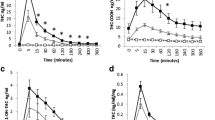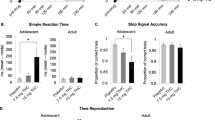Abstract
Background
Cannabis is the most common illicit drug used in the USA and its use has been rising over the past decade, while the historical gap in rates of use between men and women has been decreasing. Sex differences in the effects of cannabinoids have been reported in animal models, but human studies are sparse and inconsistent. We investigated the sex differences in the acute subjective, psychotomimetic, cognitive, and physiological effects of intravenous (IV) delta-9 tetrahydrocannabinol (THC), the main psychoactive constituent of cannabis.
Methods
Healthy male and female individuals, with limited exposure to cannabis, participated in a double blind, placebo-controlled study of intravenous (IV) placebo or THC at two doses (0.015 mg/kg and 0.03 mg/kg). Visual analog scale (VAS) was used to measure subjective effects, Psychotomimetic States Inventory (PSI) and the Clinician-Administered Dissociative Symptoms Scale (CADSS) were used to assess the psychotomimetic effects and perceptual alterations, respectively, and Rey Auditory Verbal Learning Task (RAVLT) was used to evaluate cognitive effects. Outcome variables were represented as the peak change from baseline for each variable, except RAVLT which was used only once per the test day after the subjective effects.
Results
A total of 42 individuals participated in this study. There were no significant differences between male and female participants in background characteristics. There was a significant main effect of sex on the VAS scores for THC-induced “High” (F1,38 = 4.27, p < 0.05) and a significant dose × sex interaction (F2,77 = 3.38, p < 0.05) with female participants having greater “High” scores than male participants at the lower THC dose (0.015 mg/kg). No other sex differences were observed in acute subjective, psychotomimetic, cognitive, or physiological effects of THC.
Conclusion
There were significant sex differences in subjective effects of feeling “High” at a lower dose of THC. However, there were no other sex-related differences in the subjective, physiological, or cognitive effects of THC.

Similar content being viewed by others
References
Quality, C.f.B.H.S.a., National Survey on Drug Use and Health: detailed tables. Substance Abuse and Mental Health Services Administration, 2020.
Chapman C et al (2017) Evidence for sex convergence in prevalence of cannabis use: a systematic review and meta-regression. J Stud Alcohol Drugs 78(3):344–352
Johnson RM et al (2015) Past 15-year trends in adolescent marijuana use: differences by race/ethnicity and sex. Drug Alcohol Depend 155:8–15
Khan SS et al (2013) Gender differences in cannabis use disorders: results from the National Epidemiologic Survey of Alcohol and Related Conditions. Drug Alcohol Depend 130(1–3):101–108
Hernandez-Avila CA, Rounsaville BJ, Kranzler HR (2004) Opioid-, cannabis- and alcohol-dependent women show more rapid progression to substance abuse treatment. Drug Alcohol Depend 74(3):265–272
Copersino ML et al (2010) Sociodemographic characteristics of cannabis smokers and the experience of cannabis withdrawal. Am J Drug Alcohol Abuse 36(6):311–319
Lev-Ran S et al (2012) Gender differences in health-related quality of life among cannabis users: results from the National Epidemiologic Survey on Alcohol and Related Conditions. Drug Alcohol Depend 123(1–3):190–200
Cooper ZD, Craft RM (2018) Sex-dependent effects of cannabis and cannabinoids: a translational perspective. Neuropsychopharmacology 43(1):34–51
Fattore L et al (2007) Cannabinoid self-administration in rats: sex differences and the influence of ovarian function. Br J Pharmacol 152(5):795–804
Fattore L et al (2010) Drug- and cue-induced reinstatement of cannabinoid-seeking behaviour in male and female rats: influence of ovarian hormones. Br J Pharmacol 160(3):724–735
Cocchetto DM et al (1981) Relationship between plasma delta-9-tetrahydrocannabinol concentration and pharmacologic effects in man. Psychopharmacology 75(2):158–164
Haney M (2007) Opioid antagonism of cannabinoid effects: differences between marijuana smokers and nonmarijuana smokers. Neuropsychopharmacology : Official Publication of the American College of Neuropsychopharmacology 32(6):1391–1403
Penetar DM et al (2005) Transdermal nicotine alters some of marihuana’s effects in male and female volunteers. Drug Alcohol Depend 79(2):211–223
Makela P et al (2006) Low doses of delta-9 tetrahydrocannabinol (THC) have divergent effects on short-term spatial memory in young, healthy adults. Neuropsychopharmacology 31(2):462–470
Fogel JS et al (2017) Sex differences in the subjective effects of oral delta(9)-THC in cannabis users. Pharmacol Biochem Behav 152:44–51
Cooper ZD, Haney M (2009) Comparison of subjective, pharmacokinetic, and physiological effects of marijuana smoked as joints and blunts. Drug Alcohol Depend 103(3):107–113
Cooper, Z.D. and M. Haney, Investigation of sex-dependent effects of cannabis in daily cannabis smokers. Drug and Alcohol Dependence, 2014.
Mathew RJ, Wilson WH, Davis R (2003) Postural syncope after marijuana: a transcranial Doppler study of the hemodynamics. Pharmacol Biochem Behav 75(2):309–318
Matheson J et al (2020) Sex differences in the acute effects of smoked cannabis: evidence from a human laboratory study of young adults. Psychopharmacology 237(2):305–316
D’Souza DC et al (2008) Effects of haloperidol on the behavioral, subjective, cognitive, motor, and neuroendocrine effects of Δ-9-tetrahydrocannabinol in humans. Psychopharmacology 198(4):587–603
D’Souza DC et al (2004) The psychotomimetic effects of intravenous delta-9-tetrahydrocannabinol in healthy individuals: implications for psychosis. Neuropsychopharmacology 29(8):1558–1572
Cortes-Briones J et al (2015) Δ9-THC disrupts gamma (γ)-band neural oscillations in humans. Neuropsychopharmacology 40(9):2124–2134
Boggs DL et al (2018) The dose-dependent psychomotor effects of intravenous delta-9-tetrahydrocannabinol (Δ(9)-THC) in humans. J Psychopharmacol 32(12):1308–1318
Ranganathan M et al (2017) Tetrahydrocannabinol (THC) impairs encoding but not retrieval of verbal information. Prog Neuropsychopharmacol Biol Psychiatry 79:176–183
Parks C et al (2020) Sex and strain variation in initial sensitivity and rapid tolerance to Δ9-tetrahydrocannabinol. Cannabis Cannabinoid Res 5(3):231–245
Lunn S et al (2019) Human pharmacokinetic parameters of orally administered delta(9)-tetrahydrocannabinol capsules are altered by fed versus fasted conditions and sex differences. Cannabis Cannabinoid Res 4(4):255–264
Naef M et al (2004) Development and pharmacokinetic characterization of pulmonal and intravenous delta-9-tetrahydrocannabinol (THC) in humans. J Pharm Sci 93(5):1176–1184
Wall ME et al (1983) Metabolism, disposition, and kinetics of delta-9-tetrahydrocannabinol in men and women. Clin Pharmacol Ther 34(3):352–363
Carbuto M et al (2012) The safety of studies with intravenous delta(9)-tetrahydrocannabinol in humans, with case histories. Psychopharmacology 219(3):885–896
D’Souza DC et al (2012) Dose-related modulation of event-related potentials to novel and target stimuli by intravenous delta(9)-THC in humans. Neuropsychopharmacology : Official Publication of the American College of Neuropsychopharmacology 37(7):1632–1646
Nia AB et al (2018) Cannabis use: neurobiological, behavioral, and sex/gender considerations. Curr Behav Neurosci Rep 5(4):271–280
Weed PF et al (2016) Chronic Δ9-tetrahydrocannabinol during adolescence differentially modulates striatal CB1 receptor expression and the acute and chronic effects on learning in adult rats. J Pharmacol Exp Ther 356(1):20–31
Craft RM, Kandasamy R, Davis SM (2013) Sex differences in anti-allodynic, anti-hyperalgesic and anti-edema effects of Δ(9)-tetrahydrocannabinol in the rat. Pain 154(9):1709–1717
Wakley AA, Wiley JL, Craft RM (2014) Sex differences in antinociceptive tolerance to delta-9-tetrahydrocannabinol in the rat. Drug Alcohol Depend 143:22–28
Wiley JL (2003) Sex-dependent effects of delta 9-tetrahydrocannabinol on locomotor activity in mice. Neurosci Lett 352(2):77–80
Nguyen JD et al (2020) Lasting effects of repeated ∆(9)-tetrahydrocannabinol vapour inhalation during adolescence in male and female rats. Br J Pharmacol 177(1):188–203
Farquhar CE et al (2019a) Sex, THC, and hormones: effects on density and sensitivity of CB1 cannabinoid receptors in rats. Drug Alcohol Depend 194:20–27
Burston JJ et al (2010) Regional enhancement of cannabinoid CB₁ receptor desensitization in female adolescent rats following repeated delta-tetrahydrocannabinol exposure. Br J Pharmacol 161(1):103–112
Marusich JA et al (2015) The impact of gonadal hormones on cannabinoid dependence. Exp Clin Psychopharmacol 23(4):206–216
Liu X et al (2020) Sexual dimorphic distribution of cannabinoid 1 receptor mRNA in adult C57BL/6J mice. J Comp Neurol 528(12):1986–1999
Castelli MP et al (2014) Male and female rats differ in brain cannabinoid CB1 receptor density and function and in behavioural traits predisposing to drug addiction: effect of ovarian hormones. Curr Pharm Des 20(13):2100–2113
Llorente-Berzal A et al (2013) Sex-dependent changes in brain CB1R expression and functionality and immune CB2R expression as a consequence of maternal deprivation and adolescent cocaine exposure. Pharmacol Res 74:23–33
Farquhar CE et al (2019b) Sex, THC, and hormones: effects on density and sensitivity of CB(1) cannabinoid receptors in rats. Drug Alcohol Depend 194:20–27
Rodríguez de Fonseca F et al (1994) Cannabinoid receptors in rat brain areas: sexual differences, fluctuations during estrous cycle and changes after gonadectomy and sex steroid replacement. Life Sci 54(3):159–70
Laurikainen H et al (2019) Sex difference in brain CB1 receptor availability in man. Neuroimage 184:834–842
Van Laere K et al (2008) Gender-dependent increases with healthy aging of the human cerebral cannabinoid-type 1 receptor binding using [(18)F]MK-9470 PET. Neuroimage 39(4):1533–1541
Neumeister A et al (2013) Elevated brain cannabinoid CB1 receptor availability in post-traumatic stress disorder: a positron emission tomography study. Mol Psychiatry 18(9):1034–1040
Normandin MD et al (2015) Imaging the cannabinoid CB1 receptor in humans with [11C]OMAR: assessment of kinetic analysis methods, test-retest reproducibility, and gender differences. J Cereb Blood Flow Metab 35(8):1313–1322
Funding
Anahita Bassir Nia was supported by the National Institute of Health K12 DA000167 grant.
Author information
Authors and Affiliations
Corresponding author
Ethics declarations
Conflict of interest
Anahita Bassir Nia is a member of Scientific Advisory Committee of Synendos Therapeutics AG, Switzerland. Authors have no other conflict of interest to disclose.
Additional information
Publisher's note
Springer Nature remains neutral with regard to jurisdictional claims in published maps and institutional affiliations.
Anahita Bassir Nia and Maria J. Orejarena are both first authors.
This article belongs to a Special Issue on Cannabis and Cannabinoids
Supplementary Information
Below is the link to the electronic supplementary material.
Rights and permissions
About this article
Cite this article
Bassir Nia, A., Orejarena, M.J., Flynn, L. et al. Sex differences in the acute effects of intravenous (IV) delta-9 tetrahydrocannabinol (THC). Psychopharmacology 239, 1621–1628 (2022). https://doi.org/10.1007/s00213-022-06135-3
Received:
Accepted:
Published:
Issue Date:
DOI: https://doi.org/10.1007/s00213-022-06135-3




